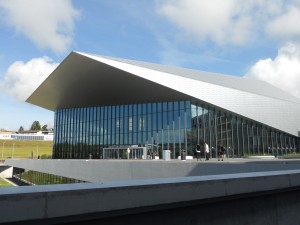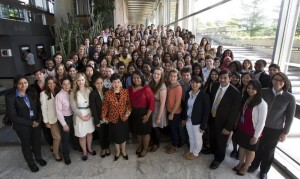Now that I have acquired groceries, mastered important bus routes, and gotten settled at work, the time seems to be going by at an alarming rate. There seems to be less and less time in a day, and my second week here in Geneva has been very eventful, so prepare yourself for a long post! I’ve tried to at least make it easy to skim through the boring parts.
Background on WHO
For those of you who might not be familiar with the organization, I thought I would provide a brief overview of what the WHO actually is and its overall purpose. The WHO is a specialized group within the United Nations, which provides leadership in global health, creates norms, standards, and guidelines for all types of health policy, and generally provides support for its 194 member states. In the short time I’ve been here, I’m constantly reminded of the fact that the WHO is really not an all-powerful authority that can impose its policies on the rest of the world, but it is a widely-respected body that can provide support and facilitate change across every continent. Its key purpose is to improve the health of its member states and its agenda and priorities are all shaped by those members every year at the World Health Assembly.
The WHO consists of the main headquarters, 6 regional offices, and many more country offices in the member states. Even within the headquarters, there is a huge amount of subdivision. There are the main clusters, then departments within those clusters, and then subgroups within the department. Rather than explaining all of this, we like to refer to our working group as the “Medical Devices Team”. And when asked what we do, it’s hard not to give either a short and incredibly vague statement that basically restates the name, or a long-winded explanation of the broad scope of the projects here in our small team.
EPFL International Conference-Technologies For Development: What is Essential?
This week I was very lucky to attend this conference on innovative medical devices at a university in the nearby city of Lousanne. Here, I ate large quantities of croissants and learned an enormous amount about some exciting new technologies being developed around the world, as well as learned more about the challenges and context of technology transfer. I spent most of the time vigorously taking notes on the speakers so that I could remember everything.
One of our keynote speakers began the conference by boldly stating that most new medical devices in the developing world are failing. Some of the reasons for this included a shortage of local leaders and the disempowerment associated with foreigners trying to single-handedly solve others’ problems, emphasis on the wrong constituents (too much on the people providing the funds), an imbalance between needs and wants (i.e. focusing on adopting a certain technology and ignoring demand), and “feel good” vs. problem solving attitudes among people working in global health. His speech was blunt and yet hopeful at the same time–a good intro to the many dedicated people who then shared their work and ideas over the rest of the conference.
Memorable Technologies
Here are the key points from some of my favorite presentations at the conference.
- Non-Trade offs: This presentation talked a lot about striking a balance between cost and utility when designing a technology. And most importantly, it is crucial to identify those aspects that are entirely non-negotiable for your design. These non-trade offs (NTO’s) can be imposed when reducing a technology from a broader scale down to a local scale, or can emerge naturally from the process of scaling-up a technology. In either case, the importance of end-users above all is emphasized.
- D–Rev prosthetic and issues with local production: An American from D-Rev presented on a cool new type of prosthetic knee being implemented in low-resource settings. Some interesting aspects of the project included a mixed translation for usage (partly in Afrikaans or other local languages, and partly in English) to best suit their need, as well as creating a new assessment method to fit the context of their device usage, rather than using the same, irrelevant methods that are used for prosthetics in the developed world. An interesting issue that was brought up was particularly pertinent to one of my projects-Local Production and Technology Transfer. They are currently using centralized manufacturing and then bringing the devices to other countries, partly because quality control can be a huge issue when you start producing devices locally at many different sites.
- Mosquito control device that can power homes: This was definitely my favorite project at the conference. This is an amazing new device, done completely locally in Tanzania, which uses a special formulation of short-range attractant chemicals to draw in mosquitoes to this box, kills the mosquitoes within milliseconds with an electric grid, and can also use its solar panels to power homes or potentially power wi-fi hotspots. The purpose is to combat the prevent incidence of malaria where bed nets and house treatments are useless–outside. I was surprised to learn that mosquitoes are in fact the deadliest animals in the world! What I really loved about this project was that it had its roots in Tanzania and continued to keep the community involved. They even did surveys to find out about where the mosquito heavy areas are (and found the results to be consistent with the trials done with the boxes). And in addition to reducing the risk of malaria while doing outdoor activities, the solar panel aspect has the potential to improve the quality of life for people without electricity, as well as provide an incentive for individuals and the government to invest in this device.
- Mobile Health for Cardiovascular Disease: One interesting part of this project was how they were able to adapt to the fact that many of their older patients did not know their birthdate. The technology involve assessing risk for CVD, so the age of the patients is an important piece of information. To get this info, they created an age estimator, which asks the user their approximate age when large historical events took lace. Users tended to remember very well their stage of life when certain political or cultural events took place, which then improved their patient evaluation.
- Open Source mHealth: The engineer during this presentation said that spending time in the clinic watching his new system being used was an invaluable tool for improving it. He said himself–it sounds so simple, but it really can make a world of difference when you’re trying to optimize your device for the end-users. Often, the clinicians and end-users are unaware of what aspects of the device actually can be modified, so by observing how the system was being used and how people reacted to it, he could much more easily identify ways to make it better.
Meeting with the Director General
Today I had the pleasure of attending a meeting with the Director General of the WHO, Dr. Margaret Chan, along with the rest of the interns. The best way I can think of to describe her speaking style is crisp. She kept the entire room engaged with her blunt advice, honest opinions on health topics, and even had us laughing at her sarcasm and jokes. After an hour and a half of meeting with us, someone came to summon her, at which point she said, “Let me check my schedule, this is an interesting group”. (She stayed for almost 30 more minutes). It says a lot about her dedication to every member of the WHO–even the lowly interns–that she was willing to take so much time out of her busy schedule to spend with us. During her talk she answered our questions and covered everything from LGBT issues, advice for aspiring women in the professional world, bureaucracy as a form of protection, learning to properly criticize others, collaboration among clusters at the WHO, food shortages, and more. I wish I could just get a life lesson from Dr. Chan on a daily basis!
Outside of the Office
When I am not attending meetings and knee-deep in surveys and spreadsheets, I have been exploring. Although the pictures really do not even do it justice, here are some cool pictures from the weekends.


